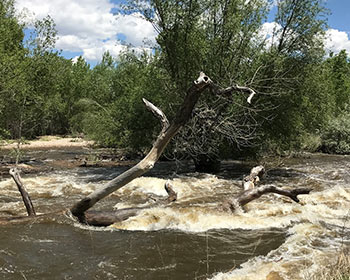

MPC Research Reports |
| Title: | Quantifying Mountain Basin Runoff Mechanisms for Better Hydrologic Design |
| Authors: | Douglas D. Woolridge, Jeffrey D. Niemann, Mark A. Perry, Kallie E. Bauer, and William T. McCormick III |
| University: | Colorado State University |
| Publication Date: | Sep 2020 |
| Report #: | MPC-20-419 |
| Project #: | MPC-537 |
| TRID #: | 01753083 |
| Keywords: | dams, history, hydrology, mountains, river basins, runoff, simulation, storms, streamflow |
 Hydrologic analyses are used for dam safety evaluations to determine the flow a dam must pass without failing. They are also used to evaluate bridge and culvert designs. Many current guidelines model flood runoff solely by an infiltration-excess mechanism. Saturation-excess runoff and subsurface stormflow mechanisms are known to be important for common events in forested regions, but few studies have analyzed their role for extreme events. The objectives of this study are to determine the active streamflow mechanisms for large historical storms and design storms in the Colorado Front Range and to propose methods to model these mechanisms that can be used by consultants. Hydrologic models were developed for five basins to simulate historical events in 1976, 1997, and 2013. The model results show saturation-excess was the dominant mechanism during the 2013 storm, which had a long duration and low rainfall intensities. Infiltration-excess runoff was dominant for the 1976 storm, which had a short duration and high intensities. Surface runoff was not observed during the 1997 storm. Similarly, infiltration-excess dominates for short duration design storms, and saturation-excess dominates for longer design storms.Hydrologic analyses are used for dam safety evaluations to determine the flow a dam must pass without failing. They are also used to evaluate bridge and culvert designs. Many current guidelines model flood runoff solely by an infiltration-excess mechanism. Saturation-excess runoff and subsurface stormflow mechanisms are known to be important for common events in forested regions, but few studies have analyzed their role for extreme events. The objectives of this study are to determine the active streamflow mechanisms for large historical storms and design storms in the Colorado Front Range and to propose methods to model these mechanisms that can be used by consultants. Hydrologic models were developed for five basins to simulate historical events in 1976, 1997, and 2013. The model results show saturation-excess was the dominant mechanism during the 2013 storm, which had a long duration and low rainfall intensities. Infiltration-excess runoff was dominant for the 1976 storm, which had a short duration and high intensities. Surface runoff was not observed during the 1997 storm. Similarly, infiltration-excess dominates for short duration design storms, and saturation-excess dominates for longer design storms.
Hydrologic analyses are used for dam safety evaluations to determine the flow a dam must pass without failing. They are also used to evaluate bridge and culvert designs. Many current guidelines model flood runoff solely by an infiltration-excess mechanism. Saturation-excess runoff and subsurface stormflow mechanisms are known to be important for common events in forested regions, but few studies have analyzed their role for extreme events. The objectives of this study are to determine the active streamflow mechanisms for large historical storms and design storms in the Colorado Front Range and to propose methods to model these mechanisms that can be used by consultants. Hydrologic models were developed for five basins to simulate historical events in 1976, 1997, and 2013. The model results show saturation-excess was the dominant mechanism during the 2013 storm, which had a long duration and low rainfall intensities. Infiltration-excess runoff was dominant for the 1976 storm, which had a short duration and high intensities. Surface runoff was not observed during the 1997 storm. Similarly, infiltration-excess dominates for short duration design storms, and saturation-excess dominates for longer design storms.Hydrologic analyses are used for dam safety evaluations to determine the flow a dam must pass without failing. They are also used to evaluate bridge and culvert designs. Many current guidelines model flood runoff solely by an infiltration-excess mechanism. Saturation-excess runoff and subsurface stormflow mechanisms are known to be important for common events in forested regions, but few studies have analyzed their role for extreme events. The objectives of this study are to determine the active streamflow mechanisms for large historical storms and design storms in the Colorado Front Range and to propose methods to model these mechanisms that can be used by consultants. Hydrologic models were developed for five basins to simulate historical events in 1976, 1997, and 2013. The model results show saturation-excess was the dominant mechanism during the 2013 storm, which had a long duration and low rainfall intensities. Infiltration-excess runoff was dominant for the 1976 storm, which had a short duration and high intensities. Surface runoff was not observed during the 1997 storm. Similarly, infiltration-excess dominates for short duration design storms, and saturation-excess dominates for longer design storms.
Woolridge, Douglas D., Jeffrey D. Niemann, Mark A. Perry, Kallie E. Bauer, and William T. McCormick III. Quantifying Mountain Basin Runoff Mechanisms for Better Hydrologic Design, MPC-20-419. North Dakota State University - Upper Great Plains Transportation Institute, Fargo: Mountain-Plains Consortium, 2020.